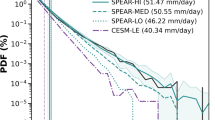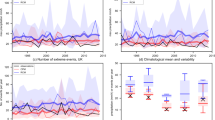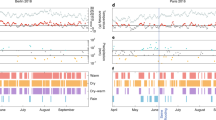Abstract
The intensification of precipitation extremes with climate change1 is of key importance to society as a result of the large impact through flooding. Observations show that heavy rainfall is increasing on daily timescales in many regions2, but how changes will manifest themselves on sub-daily timescales remains highly uncertain. Here we perform the first climate change experiments with a very high resolution (1.5 km grid spacing) model more typically used for weather forecasting, in this instance for a region of the UK. The model simulates realistic hourly rainfall characteristics, including extremes3,4, unlike coarser resolution climate models5,6, giving us confidence in its ability to project future changes at this timescale. We find the 1.5 km model shows increases in hourly rainfall intensities in winter, consistent with projections from a coarser 12 km resolution model and previous studies at the daily timescale7. However, the 1.5 km model also shows a future intensification of short-duration rain in summer, with significantly more events exceeding the high thresholds indicative of serious flash flooding. We conclude that accurate representation of the local storm dynamics is an essential requirement for predicting changes to convective extremes; when included we find for the model here that summer downpours intensify with warming.
This is a preview of subscription content, access via your institution
Access options
Subscribe to this journal
Receive 12 print issues and online access
$209.00 per year
only $17.42 per issue
Buy this article
- Purchase on Springer Link
- Instant access to full article PDF
Prices may be subject to local taxes which are calculated during checkout




Similar content being viewed by others
References
Trenberth, K. E., Dai, A., Rasmussen, R. M. & Parsons, D. B. The changing character of precipitation. Bull. Am. Meteorol. Soc. 84, 1205–1217 (2003).
Min, S-K., Zhang, X., Zwiers, F. W. & Hegerl, G. C. Human contribution to more-intense precipitation extremes. Nature 470, 376–379 (2011).
Kendon, E. J., Roberts, N. M., Senior, C. A. & Roberts, M. J. Realism of rainfall in a very high resolution regional climate model. J. Clim. 25, 5791–5806 (2012).
Chan, S. C. et al. The value of high-resolution Met Office regional climate models in the simulation of multi-hourly precipitation extremes. J. Clim. http://dx.doi.org/10.1175/JCLI-D-13-00723.1 (in the press).
Hanel, M. & Buishand, T. A. On the value of hourly precipitation extremes in regional climate model simulations. J. Hydrol. 393, 265–273 (2010).
Gregersen, I. B. et al. Assessing future climatic changes of rainfall extremes at small spatio-temporal scales. Climatic Change 118, 783–797 (2013).
Fowler, H. J. & Ekström, M. Multi-model ensemble estimates of climate change impacts on UK seasonal precipitation extremes. Int. J. Climatol. 29, 385–416 (2009).
Lenderink, G. & van Meijgaard, E. Increase in hourly precipitation extremes beyond expectations from temperature changes. Nature Geosci. 1, 511–514 (2008).
Burt, S. Cloudburst upon Hendraburnick Down: The Boscastle storm of 16 August 2004. Weather 60, 219–227 (2005).
Berg, P., Moseley, C. & Haerter, J. O. Strong increase in convective precipitation in response to higher temperatures. Nature Geosci. 6, 181–185 (2013).
Brockhaus, P., Lüthi, D. & Schär, C. Aspects of the diurnal cycle in a regional climate model. Meteorol. Z. 17, 433–443 (2008).
Hohenegger, C., Brockhaus, P. & Schär, C. Towards climate simulations at cloud-resolving scales. Meteorol. Z. 17, 383–394 (2008).
Lean, H. W. et al. Characteristics of high-resolution versions of the Met Office Unified Model for forecasting convection over the United Kingdom. Mon. Weath. Rev. 136, 3408–3424 (2008).
Langhans, W., Schmidli, J., Fuhrer, O., Bieri, S. & Schär, C. Long-term simulations of thermally driven flows and orographic convection at convection-parameterizing and cloud-resolving resolutions. J. Appl. Meteorol. Clim. 52, 1490–1510 (2013).
Prein, A. F. et al. Added value of convection permitting seasonal simulations. Clim. Dynam. 41, 2655–2677 (2013).
Mahoney, K., Alexander, M., Scott, J. D. & Barsugli, J. High-resolution downscaled simulations of warm-season extreme precipitation events in the Colorado Front Range under past and future climates. J. Clim. 26, 8671–8689 (2013).
Attema, J. J., Loriaux, J. M. & Lenderink, G. Extreme precipitation response to climate perturbations in an atmospheric mesoscale model. Environ. Res. Lett. 9, 014003 (2014).
Wakazuki, Y., Nakamura, M., Kanada, S. & Muroi, C. Climatological reproducibility evaluation and future climate projection of extreme precipitation events in the Baiu Season using a high-resolution non-hydrostatic RCM in comparison with an AGCM. J. Meteorol. Soc. Jpn 86, 951–967 (2008).
Knote, C., Heinemann, G. & Rockel, B. Changes in weather extremes: Assessment of return values using high resolution climate simulations at convection-resolving scale. Meteorol. Z. 19, 11–23 (2010).
Trapp, R. J., Robinson, E. D., Baldwin, M. E., Diffenbaugh, N. S. & Schwedler, B. R. J. Regional climate of hazardous convective weather through high-resolution dynamical downscaling. Clim. Dynam. 37, 677–688 (2011).
Hohenegger, C., Brockhaus, P., Bretherton, C. S. & Schär, C. The soil moisture-precipitation feedback in simulations with explicit and parameterized convection. J. Clim. 22, 5003–5020 (2009).
Pan, L-L. et al. Influences of climate change on California and Nevada regions revealed by a high-resolution dynamical downscaling study. Clim. Dynam. 37, 2005–2020 (2011).
Golding, B. W. Nimrod: A system for generating automated very short range forecasts. Meteorol. Appl. 5, 1–16 (1998).
Harrison, D. L., Driscoll, S. J. & Kitchen, M. Improving precipitation estimates from weather radar using quality control and correction techniques. Meteorol. Appl. 7, 135–144 (2000).
Walters, D. N. et al. The Met Office Unified Model global atmosphere 3.0/3.1 and JULES global land 3.0/3.1 configurations. Geosci. Model Dev. 4, 919–941 (2011).
Wilkinson, J. M. et al. Improved microphysical parametrization of drizzle and fog for operational forecasting using the Met Office Unifed Model. Q. J. R. Meteorol. Soc. 139, 488–500 (2013).
Li, D. & Shine, K. P. A 4-dimensional Ozone Climatology for UGAMP Models. Technical Report 35 (UGAMP 1995)
Collins, W. J. et al. Development and evaluation of an Earth-System model—HadGEM2. Geosci. Model Dev. 4, 1051–1075 (2011).
Bower, K. N. & Choularton, T. W. A parametrisation of the effective radius of ice free clouds for use in global climate models. Atmos. Res. 27, 305–339 (1992).
Best, M. J. et al. The Joint UK Land Environment Simulator (JULES), model description—Part 1: Energy and water fluxes. Geosci. Model Dev. 4, 595–640 (2011).
Acknowledgements
Thanks to colleagues across the UK Met Office for their help in setting up the 1.5 km and 12 km model experiments, especially C. Wang, J. Bornemann and W. Moufouma-Okia. Also thanks to J. Wilkinson, P. Field, C. Pilling and H. Lean for useful discussions. We gratefully acknowledge funding from the Joint Department of Energy and Climate Change (DECC) and Department for Environment Food and Rural Affairs (Defra) Met Office Hadley Centre Climate Programme (GA01101). This work also forms part of a joint UK Met Office and Natural Environment Research Council (UKMO-NERC) funded project on Convective Extremes (CONVEX, NE/1006680/1).
Author information
Authors and Affiliations
Contributions
E.J.K. carried out the 1.5 km and 12 km model experiments and wrote the paper. N.M.R. analysed the performance of the 1.5 km model from weather forecasts, produced Supplementary Fig. 1, and along with H.J.F. extensively contributed to the manuscript. M.J.R. ran the 60 km global model experiments. All authors discussed the results and commented on the manuscript.
Corresponding author
Ethics declarations
Competing interests
The authors declare no competing financial interests.
Supplementary information
Rights and permissions
About this article
Cite this article
Kendon, E., Roberts, N., Fowler, H. et al. Heavier summer downpours with climate change revealed by weather forecast resolution model. Nature Clim Change 4, 570–576 (2014). https://doi.org/10.1038/nclimate2258
Received:
Accepted:
Published:
Issue Date:
DOI: https://doi.org/10.1038/nclimate2258
This article is cited by
-
The climate change response of alpine-mediterranean heavy precipitation events
Climate Dynamics (2024)
-
Shifts in flood generation processes exacerbate regional flood anomalies in Europe
Communications Earth & Environment (2023)
-
An Observation-Based Dataset of Global Sub-Daily Precipitation Indices (GSDR-I)
Scientific Data (2023)
-
Large-scale dynamics moderate impact-relevant changes to organised convective storms
Communications Earth & Environment (2023)
-
Variability conceals emerging trend in 100yr projections of UK local hourly rainfall extremes
Nature Communications (2023)



